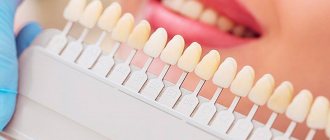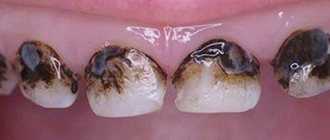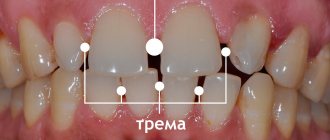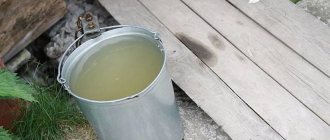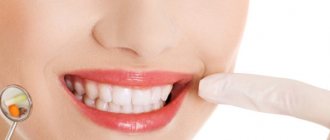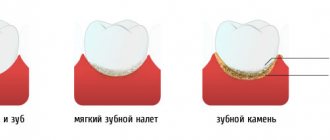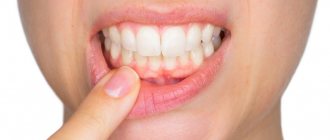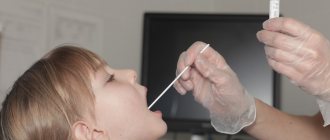Every person dreams of smiling and conquering those around him with his snow-white smile. In modern conditions, there are a huge number of options for whitening teeth. And here it is important not to make a mistake with the choice. After all, you want the chosen method to be safe, effective and relatively inexpensive. And with all this, the result would be noticeable on the same day. In this article we will tell you about the different methods of teeth whitening and their features, and what questions patients most often ask before this procedure.
Who should really whiten their teeth?
The main reason for teeth whitening is darkening or yellowing of tooth enamel, when plaque penetrates into the teeth so deeply that ordinary hygiene procedures do not help get rid of it.
Causes of darkening of enamel:
- Smoking.
Nicotine settles on tooth enamel and penetrates deep into it. Teeth take on an extremely unaesthetic “smoky” appearance. Toothpastes with a whitening effect are too mild to cope with the plaque of tobacco tars and nicotine. Home whitening will restore the natural whiteness of your teeth, but they may darken again due to a negative habit;
- Excessive consumption of sweets.
The interaction of microorganisms living in the mouth with carbohydrates leads to biochemical reactions with the release of various substances. They act aggressively on teeth. The enamel becomes so thin that yellow dentin shows through;
- Drinking coffee and strong tea.
Drinks with dyes negatively affect the color of tooth enamel, which can no longer be called snow-white. The color of enamel is affected by red wine, strong tea, natural and instant coffee. Brown plaque on teeth quickly appears with regular consumption of these drinks;
- Use of the antibiotic tetracycline.
If the expectant mother took tetracycline while expecting her baby, the baby's tooth buds will turn yellow. The same effect occurs if children take tetracycline during tooth formation in early childhood (“tetracycline teeth”);
- Excessive intake of fluorine compounds.
Environmental problems associated with poor-quality water or air, food, can cause the development of fluorosis due to an excess of fluoride in the body. This disease is characterized by pockmarked enamel (“speckled teeth”);
- Underdevelopment of dental tissues.
Hypoplasia appears on the teeth in the form of white or yellow spots. They are symmetrical and the same size. If signs of hypoplasia are noticeable when communicating with a person, the affected areas of the teeth are filled or whitened.
Indications
Professional lightening is indicated in the following cases:
- change in shade due to injury, taking certain medications;
- smoking, eating foods with bright colors;
- age-related darkening of teeth;
- the appearance of a yellowish dense plaque, which negatively affects the aesthetics of the smile.
What do you need to know when trying to whiten your teeth at home?
Teeth whitening is similar to hair bleaching and affects a person's health. Minimizing the harm caused to the body is the main goal of bleaching.
Before teeth whitening, it is advisable to consult a dentist to assess the quality of tooth enamel. It must be strong enough and have the required thickness. The yellowness that forms on the teeth should not penetrate far into the enamel, in which case the home procedure will not bring results.
Before performing a home cosmetic procedure, dental health is assessed for pathologies: periodontitis, periodontitis, alveolar processes, cement fillings, abnormal eruption of wisdom teeth.
Assessing the condition of the fillings is not an unnecessary precaution. If gaps appear between the filling and the tooth tissue, an aggressive substance will penetrate through them and cause destruction of the tooth from the inside.
After treating the enamel and obtaining the desired effect, it is not advisable to smoke or consume products with coloring pigments. Hygienic brushing of teeth should be carried out with a soft toothbrush, as stiffer bristles can cause discomfort. Whitening toothpaste will help maintain the achieved effect.
The procedure for whitening tooth enamel is repeated after 2-4 months.
What teeth should be naturally?
We can list many examples that were considered a trend at one time, but at the same time were harmful to health. For example, women's corsets, which squeezed the internal organs so that they took away their breath and disrupted the functioning of the internal organs. The situation with teeth is approximately the same. Dentists confirm that our human smile is not snow-white by nature, but yellowish. This is normal and indicates oral health.
Despite popular belief, the enamel that covers the tooth is almost transparent and not white. Beneath it is dentin, the main tissue of the tooth, which naturally has a yellowish tint. It is this that “shines through” the enamel and gives it its characteristic yellowness. And most importantly, this shade indicates the health of the teeth, their strength and resistance to caries. If a person’s teeth are naturally too white, this indicates poor enamel mineralization and requires treatment.
Therefore, the first thing when consulting a visitor with the problem of yellow teeth is to determine whether the problem is acquired or whether it is a habitual condition of the teeth.
Who should not whiten their teeth and when?
Before you begin whitening your teeth at home or at the dentist, you need to determine the reason for the change in their shade. Darkening or yellowing of teeth can be external or internal, and only external staining can be corrected using traditional methods. Internal causes of tooth discoloration can be very diverse, ranging from enamel hypoplasia, through which darker dentin tissues are visible, to chronic accumulation of brass, tin, iron and other substances.
In addition, there are a number of contraindications for teeth whitening:
- Pregnant women and people with systemic diseases should not undergo whitening in dental offices. As an alternative, you can use some of the tooth-friendly home whitening products, such as activated charcoal;
- Periodontal diseases are a contraindication to whitening, since the lightening components can aggravate the condition of the tissues, provoke bleeding gums and a number of other pathologies;
- For patients with large carious cavities and untreated diseases of the teeth and gums, whitening is contraindicated;
- People who have a lot of fillings in visible areas are not recommended to whiten their teeth, since the aesthetic value of the result in this case is minimal - the fillings either cannot be whitened or lighten too much. After the whitening procedure, you will have to replace them, which can be difficult if there are a lot of fillings;
- Teeth whitening is contraindicated for children under 16 years of age, since their hard tooth tissues are not fully formed, and the bleaching substance can penetrate through them to the nerves and damage them;
- People who wear braces or have recently had them removed should not whiten their teeth. Braces themselves damage tooth enamel, especially the areas of the teeth to which the clasps are attached. After their removal, the teeth do not lose sensitivity for several weeks; it is necessary to maintain this period until complete recovery.
Why do teeth change color?
In order to properly conduct a consultation, a pharmacist or pharmacist must find out the cause of the defect. Dentists identify a number of factors that change the color of teeth:
- Consumption of certain foods and drinks that contain natural or artificial colors: blueberries, chocolate, beets, black tea, coffee, dark juices, etc.
- Bad habits. Smoking and chewing tobacco gives an unsightly yellow tint and spoils the overall condition of teeth.
- Insufficient hygiene. Improper and irregular tooth brushing is the main factor in changing the shade of dentin
- Caries and other dental diseases;
- Internal causes: lack or excess of fluoride, metabolic disorders, genetic diseases
- Fillings and restorations
- Aging. Dentin turns yellow with age
- Taking medications: tetracycline, iron and others
- A combination of several reasons.
A pharmacist or pharmacist can help with the first three reasons. If systemic or dental diseases are suspected, the visitor should be advised to consult a doctor.
How to whiten teeth enamel with activated carbon?
Activated carbon is a safe means of teeth whitening at home, minimizing mechanical damage to the enamel. In addition, if accidentally swallowed, activated carbon does not cause harm to the body, which cannot be said about other bleaching agents.
The whitening properties of activated carbon components have been known for a long time - one of the “grandmother’s” recipes for a snow-white smile includes brushing your teeth with wood ash. Wood ash was used as tooth powder or simply chewed, trying to do it so that all surfaces of the tooth were affected. This technique has a scientific basis - wood ash contains potassium hydroxide, a powerful abrasive substance that removes plaque from the chewing surface and prevents the formation of stains on the teeth.
Activated carbon can be made from wood ash, fruit seeds, and coconut shells. Activated carbon tablets can be crushed into powder, the fine particles of which will not injure your teeth. You need to brush your teeth with activated carbon in the same way as with tooth powder, but do not press too hard on the brush so as not to scratch the enamel.
A quick way to whiten teeth without preparing powder is to chew two or three tablets at once, then rinse your mouth with warm water several times. Despite all the beneficial whitening properties of charcoal, immediately after the procedure, the smile may “blacken” due to powder particles stuck in the interdental spaces. They are washed thoroughly, after which you can brush your teeth with regular toothpaste.
The positive effect of this procedure lies not only in the abrasive effect of activated carbon, which removes soft plaque, but also in its absorbent effect. Charcoal absorbs toxins, acid-forming substances that can damage tooth enamel and cause stains on its surface. However, you should not use charcoal powder to clean your teeth too often to avoid damage to the enamel and tooth hypersensitivity.
Contraindications
Even if the patient has figured out what is the most effective and best method of teeth whitening, it is necessary to make sure that there are no restrictions. The procedure is contraindicated in:
- gestation and lactation period;
- the patient’s minor age, primary occlusion;
- individual intolerance to the components of whitening products;
- presence of orthodontic structures;
- oncological processes and undergoing a course of chemotherapy;
- damage to hard and soft tissues due to traumatic or other impacts;
- installed artificial prostheses;
- chronic pathologies of teeth and gums in the acute stage, acute dental diseases.
Each case is considered by the dentist individually. If you whiten your teeth if there are absolute restrictions, this can lead to serious complications.
Teeth whitening with lemon
Therapeutic procedures for teeth using lemon are chemical methods of enamel whitening. They are less traumatic than abrasive bleaching with soda or activated carbon, since the degree of impact can be controlled by simply reducing or increasing the concentration of lemon juice in the solution. Whereas when brushing your teeth with soda, there is a risk of scratching the enamel even with minimal pressure from the toothbrush.
There are several simple and effective recipes using lemon:
- Thoroughly wipe the front surface of the teeth with the peel of a fresh lemon for 3-5 minutes. Make sure that there are no particles of peel or any other food left in the spaces between the teeth. It is a proven fact that the greatest risk for the development of caries, damage and darkening of tooth enamel is not one-time exposure to acid-forming or coloring substances, but the constant presence of food debris. This creates a breeding ground for pathogenic microorganisms that cause most pathologies of the teeth and oral cavity in general;
- A gentle treatment method that is suitable even for people with sensitive teeth. Before brushing your teeth, add 1-2 drops of lemon juice to the toothpaste and carry out the hygiene procedure as usual. Practice no more than twice a week for one month;
- Lemon pulp is used to lighten teeth whose enamel is insensitive to acids. Apply a fresh slice of lemon to your teeth for a couple of minutes until discomfort occurs, then remove and rinse your mouth with warm water;
- A solution of lemon juice in a glass of water can be used to rinse the mouth, using a course of no more than a month. The ratio of the solution components is 1:1, you can reduce the content of lemon juice in case of painful teeth reaction.
How to remove stubborn plaque?
Abrasives
You can lighten your teeth using highly abrasive pastes. From 10% to 50% of the volume of such pastes is occupied by abrasives - hard polishing particles, with the help of which plaque and food debris are removed.
The cleaning and polishing properties of toothpaste depend on the concentration of abrasive particles, their size, shape and hardness. Silicon dioxide, calcium carbonate (chalk), sodium metaphosphate and even diamond dust are used as abrasives in pastes.
In dentistry, a single standard has been adopted for assessing the abrasiveness of hygiene products and their impact on enamel - the RDA (Relative Dentin Abrasivity) abrasivity index, where:
- 0–30 – low abrasiveness;
- 30–80 – moderate abrasiveness;
- 80–150 – high abrasiveness;
- >150 - polishing pastes for use no more than 1-2 times a week.
Pastes with high abrasiveness clean more intensively and are suitable for smokers and coffee lovers.
It is better to use such pastes in cycles or alternate with strengthening ones, otherwise you can injure the enamel. If you have sensitive teeth, chips and cracks in the enamel, highly abrasive toothpastes will not be suitable. Pastes with low and medium abrasiveness can be used every day. They often add additional bleaching agents - enzymes or peroxides.
Marvis Whitening Mint Toothpaste Whitening 85 ml
Toothpaste Apagard Smokin 100 ml
ApaCare Polish Polishing Toothpaste
ISME RasYan Herbal Clove Polishing Toothpaste
Enzymes
You can carefully and safely lighten enamel with pastes containing plant components - enzymes and extracts. They break down and loosen plaque, making it easier to remove. Such pastes have a low level of abrasiveness, which means they are safer for enamel. Enzymes are obtained from fruits: bromelain - from pineapple, papain - from papaya. You can brush your teeth with such pastes every day, even with sensitive enamel.
Yotuel Whitening Pharma toothpaste
Tooth cream SWISSDENT CRYSTAL (50 ml)
Toothpaste ROCS (ROCS) PRO Delicate whitening Sweet mint
Blanx Pro Pure White Toothpaste Pure white
Light
Lightening due to blue particles and pigments. Tooth enamel is able to absorb, reflect and scatter light, which affects its visible shade. Pastes containing blue particles, or pigments, create the optical illusion of whiteness. The blue undertone visually removes yellowness - this effect is used in detergents for white laundry. Such pastes give a short-term effect, because the pigments work only on the surface.
As a rule, pastes with pigments have a low or medium level of abrasiveness, since the emphasis is on the coloring effect. There are no contraindications for such pastes.
Blanx Pro Pure White Toothpaste Pure white
Blanx White Shock toothpaste 50 ml with activator lamp
Homemade enamel lightening with soda
Baking soda can be used for at-home teeth whitening as an abrasive that helps remove soft plaque from the enamel surface. To do this, dilute soda with water to a homogeneous paste, apply it to a brush and brush your teeth. Or leave the medicinal composition on the teeth for a few minutes, then rinse with warm water.
A combination of peroxide and soda, which are mixed until smooth and used instead of toothpaste, brightens the tone of teeth well. Baking soda-based recipes should not be used to clean and whiten teeth more than once every two weeks to prevent thinning of the enamel. At the same time, it is recommended to use fluoride-containing toothpastes to restore the mineral composition of tooth enamel.
When using baking soda to whiten teeth, you need to take precautions. First, make sure that baking soda does not get on your gums, as rubbing it can damage the tissues and cause them to bleed. Secondly, it should be remembered that when the enamel is thinned, this procedure can be dangerous for the teeth, provoke their increased sensitivity and even contribute to the occurrence of caries.
Precautionary measures
Even vitamins and minerals can be harmful if taken in excess or used in the wrong way.
So you need to take precautions with teeth whitening products:
- Firstly, remember about possible individual intolerance , monitor the body’s reaction and stop taking it if even mild signs of allergy occur.
- Secondly, solutions (including soda solution) cannot be used too often . In pursuit of the fastest and most powerful effect, you can irritate the mucous membranes or increase tooth sensitivity.
- And thirdly, vegetables, fruits and nuts must be fresh and not heat-treated . Fried onions or baked apples will seem tastier to many than raw ones, but, unfortunately, they will lose a significant part of their beneficial properties.
How to whiten teeth with hydrogen peroxide?
Hydrogen peroxide is a popular means for teeth whitening, and it is used not only at home, but is also part of whitening gels that are used by dentists to professionally lighten enamel by several tones. Naturally, the concentration in all these products is different. For radical lightening, dentists use 30% hydrogen peroxide. Moreover, after each such procedure, the dentist must remineralize the teeth with a medicinal composition in order to prevent the leaching of hydroxyapatites from the enamel. At home, a 3% peroxide solution is sufficient.
There are many recipes for use. The simplest of them is to apply a moistened cotton swab to the stained surface and leave it for several minutes, after which the mouth should be rinsed with warm water. The rules for using peroxide at home are the same as for professional whitening - avoid contact with gums and other soft tissues and ingestion of the solution. In high concentrations, this drug can be dangerous to the body.
Long-term use of hydrogen peroxide can also increase tooth sensitivity to the point of causing a painful reaction not only to heat and cold, but also to sweet and sour foods. It is not recommended to use it more than once a week; after a month's course of treatment, you need to take a break for two to three months.
Endobleaching
Endodontic lightening of tooth enamel (or as it is often called intracanal whitening) is a labor-intensive procedure that allows you to lighten pulpless teeth and teeth with cracks on the enamel surface. The problem is that, being damaged, they darken from the inside over time and a superficial effect on the enamel in this case does not have a positive effect. Therefore, to lighten them, a special whitening gel is introduced into the tooth cavity, followed by a filling.
Advantages
- The method allows you to lighten damaged teeth and enamel.
- Painless procedure.
- It is possible to lighten the enamel by 8 – 10 tones.
- You can lighten only one or two affected teeth.
Flaws
- Tooth tissues become more fragile.
- To achieve maximum effect, 2–4 procedures will be required.
How to whiten teeth using peroxide and baking soda at home?
Any peroxide-based products should not be used without first testing for an allergic reaction. To do this, apply a little hydrogen peroxide to the crook of your elbow or the delicate skin of your wrist and wait a few hours. Additionally, you can conduct a test on the teeth and oral cavity using a highly diluted peroxide solution.
Only after this can you start whitening using these recipes. At the slightest feeling of burning or pain, the composition should be washed off and rinse your mouth several times with warm water. Peroxide should not be used for mouth ulcers, which often occur in heavy smokers, tongue injury during piercing, and other injuries and wounds of the oral cavity. Untreated caries and periodontal tissue diseases are also contraindications to the use of home whitening products.
The following method works most effectively: hydrogen peroxide in a 3% concentration is mixed with baking soda in equal proportions and the resulting slurry is spread with a cotton swab over the surface of the tooth enamel in places that need to be whitened. Leave the mixture for no longer than a minute, then rinse and rinse your mouth. If the composition begins to foam on the teeth, then do not worry - this is a normal part of the procedure. Swallowing the solution even in minimal quantities is prohibited. You can eat and drink no earlier than 30 minutes after the procedure.
Immediately after whitening, you should brush your teeth with fluoride toothpaste to prevent mineral loss.
Read more: Restoring tooth enamel - 5 modern methods
Toothpaste for home teeth whitening
Whitening toothpastes are most often made based on hydrogen peroxide, organic acids and components that soften their negative effect on enamel. There is another group of products whose effectiveness is based on the abrasive effect of dicalcium phosphate and silicon oxide.
In the first case, the enamel is lightened due to chemical acids and oxygen radicals, which discolor the pigments. As a result, plaque dissolves, and the substances that gave the enamel a yellow-brown tint become colorless, and the smile acquires the desired whiteness.
Abrasive toothpastes promote mechanical plaque removal, which in most cases also leads to the expected results. However, when using products from this group, there is a high probability of developing hyperesthesia - dental hypersensitivity.
The safest option is considered to be pastes based on the enzyme papain, which gently removes plaque and prevents the formation of new deposits without thinning the enamel. But such pastes do not provide instant lightening, like products with more aggressive chemical components in their composition.
Whitening and strengthening teeth with rinses
Whitening mouth rinses are mild products that do not damage tooth enamel, but help restore its mineral composition.
They may contain aggressive chemical components - for example, active oxygen, which removes plaque, brightens teeth and prevents the formation of tartar. For patients with sensitive teeth and thinned tooth enamel, there are rinses based on plant extracts of cinnamon, tea tree, cloves, and mint. They not only prevent darkening of the surface of the teeth, but also have antibacterial properties, prevent caries and gum disease.
You need to keep the rinse in your mouth for one to three minutes; the volume for a single use is two tablespoons. Recommended for daily use for a month.
Using whitening gels at home
Homemade whitening gels are used together with special trays to increase the area of contact of the active ingredients with the enamel and increase the degree of whitening. Aligners are made of flexible plastic or silicone and are placed on the upper or lower jaw, depending on which teeth need whitening.
The gel is supplied with the mouth guard, or it can be applied to the mouth guard yourself. Products from different manufacturers vary in composition. Gels for intensive lightening of tooth enamel contain hydrogen peroxide; mouth guards with this composition can be worn for no longer than half an hour; the procedure is repeated twice a day for a two-week course of treatment.
Gentle gels contain urea or carbamide peroxide in a small concentration; they can be worn without removing them for several hours. Therefore, for night whitening at home, it is better to use these gels. Moreover, wearing a mouthguard at work or in public places can cause inconvenience.
Ready-made mouthguards can be purchased at a pharmacy. However, they may not be effective enough, since the structure of the jaw and the sensitivity of the teeth are different for all people. To enhance the whitening effect, you can contact your dentist, who will make a custom mouthguard and help you choose the optimal concentration of active ingredients in the lightening gel.
Consulting algorithm
We answer questions live on VKontakte: https://vk.com/pharmznanie
You can discuss the latest news with all your Russian colleagues in chats: Telegram: https://tglink.ru/pharmordenVKontakte: https://vk.me/join/AJQ1d_D2XxaDy9IdzL0e6EqH To leave a comment on the article, you need to register or log in.
Interested in the article? You can find out even more in the section Working in a pharmacy
Teeth Whitening Strips
This modern product will allow you to achieve a visible cosmetic effect in a short time. Special strips with a brightening composition applied to them can be purchased at a pharmacy chain or in an online store. Consumers with sensitive teeth can purchase a gentler teeth whitening option.
Using the strips is very simple - you need to apply them to your teeth every day and leave them there for at least half an hour. After a month, the enamel will lighten by about 2-3 tones. The effect of a snow-white smile will last a couple of months, then the tooth enamel will darken again. A side effect of the procedure is a temporary increase in tooth sensitivity.
Whitening strips are high-end products; they are in a different price category and are more convenient to use compared to gels and trays. The strips adhere firmly to the teeth, allowing you to talk during the procedure.
The disadvantage of any whitening strips is that the interdental spaces cannot be lightened in this way.
Whitening Pencil
| This portable type of whitening gel is applied with a special applicator. After the time specified in the instructions, the composition is removed from the enamel. Consumers are offered pencil models, the active substance of which is removed by saliva, without requiring special manipulations. The concentration of the bleaching agent is insignificant compared to the gel that comes with the trays. Therefore, the pencil is used to maintain the whiteness of teeth in “camping” conditions, to remove stains from tea, coffee, and tobacco plaque. |
Teeth whitening with tea tree oil
| High-quality whitening can be carried out only with natural essential oil of 100% concentration. First, carry out regular teeth cleaning using a toothbrush and toothpaste. Then apply 2-3 drops of essential oil to the brush and distribute it over the surface of the tooth enamel. Numbness of the cheek or part of the tongue is a side effect of the procedure, after which the oral cavity is thoroughly rinsed. Cleaning enamel with tea tree oil will remove not only plaque, but also tartar. |
Risks
When choosing the type of procedure, patients are primarily interested in which teeth whitening is the safest. What are the dangers of lightening the enamel:
- increased sensitivity, thinning of the enamel layer, uneven shade;
- premature abrasion of hard tissues;
- increased fragility and fragility of teeth;
- irritation, burns of the mucous membranes of the oral cavity due to an incorrectly selected method.
Prevention of yellowing of tooth enamel
To prevent yellowing of tooth enamel, you must adhere to good oral hygiene and avoid eating foods with coloring compounds.
In addition to brightly colored sugary sodas, candies and chocolates, foods that cause enamel damage include:
- Freshly squeezed and canned fruit juices - pomegranate, orange and others. In addition to the coloring compounds (phenols), which are contained in red berries and fruits, they have acid-forming properties, which enhances the process of staining the enamel;
- Wine, and not only red wine, but also white wine is potentially dangerous. Red contains phenols and tannin, white promotes acid formation and contains tannins, which give tooth enamel a yellow tint;
- Tea, coffee - with constant use, they provoke yellowing of tooth enamel no less than cigarettes. This is especially true for lovers of strong brewed black tea and coffee lovers who drink 3-4 cups of the drink per day;
- Condiments, sauces and spices - curry, balsamic vinegar, ketchup can cause yellowing of teeth if consumed in large quantities daily;
- Fruits and vegetables of bright colors - blueberries, blackberries, beets, raspberries, cherries. With all the benefits of these products, their coloring properties cannot be denied. This doesn't mean you need to cut them out of your diet completely, just that you need to take some precautions.
Contrary to the general belief that you can neutralize the harm of products that cause enamel staining if you immediately brush your teeth after eating them, this is not so. The fact is that enamel becomes vulnerable under the influence of acids immediately after eating. If you brush your teeth immediately after eating sweets or brightly colored fruits, you can mechanically damage the enamel, which only increases its sensitivity and promotes the formation of stains.
It is better to put clean water in your mouth and hold it there for several minutes. It is also helpful to hold saliva in your mouth before swallowing. Saliva contains natural components that protect the enamel from damage. These properties of saliva are used to promote chewing gum - the chewing process promotes increased salivation. But chewing gum is not the best option for daily use, as it may contain harmful ingredients, aspartame and other sweeteners.
There are also products that promote the formation of a protective film, which makes the enamel temporarily resistant to dyes and acid-forming substances. It is recommended to include such foods (for example, steamed broccoli) in the diet more often, eating them before eating food that is potentially harmful to teeth.
Smoking is one of the common causes of yellowing of teeth; patients at dental clinics regularly whiten their teeth to remove the so-called “smoker’s plaque.” As a result of constant exposure to cigarette smoke, yellow-brown stains appear on the teeth. It is necessary to limit this bad habit or completely abandon it in order to avoid yellowing of the enamel.
Immediately after bleaching, it is recommended to avoid eating foods and drinks that are colored and smoking. This is especially true for laser or acid whitening procedures at the dentist - at this time, tooth enamel becomes especially vulnerable to pigments.
In order to prevent yellowing of teeth after whitening and to maintain its effect for a long time, it is recommended to drink drinks that can cause pigmentation through a straw. This applies to red and other brightly colored fruit juices, soda, cocktails, tea and coffee - they are also drunk through a straw when chilled.
How to remove plaque from a child’s teeth?
With ordinary white or yellowish plaque, the child’s mouth does not require professional cleaning. In this case, fragile children's enamel requires regular and careful care.
If black or brown spots appear, you should seek help from your dentist. How to remove plaque from a child’s teeth?
- Ultrasonic cleaning effectively removes even intense plaque. For children, the procedure is performed under local anesthesia. For babies under one year of age, manipulation is contraindicated.
- Blasting using abrasives (soda) is permitted from the age of seven. In case of inflammatory processes in the oral cavity and general chronic diseases (especially during exacerbations), the procedure is contraindicated.
- The manual cleaning method is used in cases where ultrasonic or jet treatment is not possible. A professional set of tools is used, with which the dentist manually cleans off the formations.
How long does whitening result last?
| After a course of teeth whitening at home, the result can last from several months to a year, of course, subject to making some changes to your usual diet. Then the enamel gradually loses its whiteness, becomes yellow or brown, and the course must be repeated. Professional whitening keeps teeth snow-white from six months to three years, if all precautions are taken in the first days after the procedure. But teeth whitening in a dental office using AirFlow abrasive technology or acidic chemical compounds has more contraindications. Another significant drawback of such procedures is that teeth can become hypersensitive for several weeks, which makes eating hot, sour and sweet foods, drinking tea and even breathing in cold weather unbearable due to painful sensations. |
Author of the article: Muravitsky Boris Viktorovich, dentist, especially for the site ayzdorov.ru
